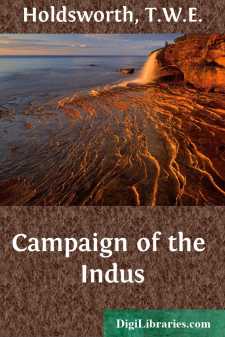Categories
- Antiques & Collectibles 13
- Architecture 36
- Art 48
- Bibles 22
- Biography & Autobiography 813
- Body, Mind & Spirit 142
- Business & Economics 28
- Children's Books 17
- Children's Fiction 14
- Computers 4
- Cooking 94
- Crafts & Hobbies 4
- Drama 346
- Education 46
- Family & Relationships 57
- Fiction 11829
- Games 19
- Gardening 17
- Health & Fitness 34
- History 1377
- House & Home 1
- Humor 147
- Juvenile Fiction 1873
- Juvenile Nonfiction 202
- Language Arts & Disciplines 88
- Law 16
- Literary Collections 686
- Literary Criticism 179
- Mathematics 13
- Medical 41
- Music 40
- Nature 179
- Non-Classifiable 1768
- Performing Arts 7
- Periodicals 1453
- Philosophy 64
- Photography 2
- Poetry 896
- Political Science 203
- Psychology 42
- Reference 154
- Religion 513
- Science 126
- Self-Help 84
- Social Science 81
- Sports & Recreation 34
- Study Aids 3
- Technology & Engineering 59
- Transportation 23
- Travel 463
- True Crime 29
Campaign of the Indus
Description:
Excerpt
LETTER I
On board the ship Syden,
Off the mouth of the Indus, Nov. 27th, 1838.
MY DEAR FATHER,—We left Belgaum on the 22nd of last month, and arrived at Bombay on the first of this; and we started from Bombay on the 18th, for this place. I had intended to write from Bombay, but everything was in such a state of confusion and bustle whilst we were there, that I literally could find no time or place for doing so. We are now at anchor off one of the mouths of the Indus, and have had a delightful voyage. Our ship is a very nice one, of 750 tons, belonging to a Swede, who is an excessively good fellow, and has treated us very well.
Sir John Keane is already arrived in the steamer Semiramis and also one of the native regiments. Our Bombay force consists of 5500 men, of which 2000 are Europeans—viz., 500 of the Queen's, and 500 of H.M. 17th regiment, one squadron of the 4th Light Dragoons, with foot and horse artillery. The rest of the force is composed of native regiments, horse and foot. We shall not land, I think, until to-morrow evening, as we are almost the only ship that has yet arrived. The infantry are divided into two brigades, and the cavalry form another by themselves. Our brigade (the first) consists of the Queen's, and the 5th and 19th regiments of Native Infantry, commanded by our worthy Colonel, now General Willshire, C.B.; the other brigade is commanded by a Company's officer. We have to go in boats about thirty miles, it is said, up the river, before we finally march. Where it is I am perfectly ignorant; however, some place between this and Hydrabad, whence we shall march as far north as Shikarpoor, where we are to form a junction with the Bengal troops, 13,000 in number, under Sir H. Fane. What our destination will be after that I know not; whether we shall advance with the Bengalees upon Herat, or form a corps of reserve on the Indus.
The country between this and Shikarpoor belongs to the Ameers of Sinde. They were very restive at first, when they heard of our intention to march through their country, and threatened to oppose our progress; but I believe they have since thought better of it; however, I do not think that they can do anything against us: time will soon shew. We have been excessively crowded on board: twenty-six officers. I have been obliged to sleep on the poop every night, which, when the dew was heavy, was by no means pleasant. I hope we shall go further than Shikarpoor, as I should like very much to see Cabool, Candahar, and all that part of the world, which so few Europeans have visited.
What is the cause of all this bustle and war I hardly know myself, and, at all events, it is too long to make the subject of a letter; I must therefore refer you to the papers for it; but I have heard from old officers that for the last twenty years the Company have been anxious to establish themselves west and north of the Indus. It is not likely, therefore, now that they have such an opportunity, that they will let it slip, so that perhaps we may be quartered there for the next two or three years....


